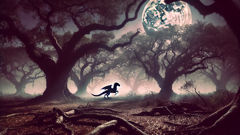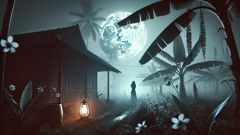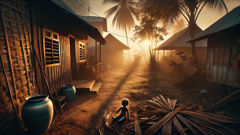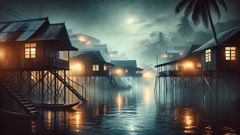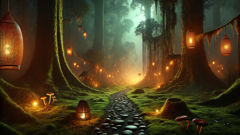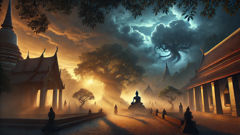Introduction
When the sun slips behind the tangled pines and sycamores of the Ozark Mountains, the valleys around Little Creek hush in anticipation. There’s a sense that these hills, stitched with veins of limestone and shrouded in ancient mist, cradle more than deer trails and bubbling brooks. Legends coil here, heavy as river fog, and none is whispered with more awe—or dread—than that of the Gowrow. Locals have spoken for generations of a monstrous, dragon-like beast rumored to dwell deep within the labyrinthine caves that riddle the Arkansas foothills. They say its eyes burn like embers in the dark, its scaly hide bristling with jagged horns and bone spurs, and its roar can shatter a man’s courage before a single claw is raised. For the people of Little Creek, the line between fear and folklore is thin, and the Gowrow walks it like a shadow at dusk. Yet, in the spring of 1897, something changed. Livestock vanished without trace, enormous claw prints gouged the mud by the riverbank, and old-timers’ tales turned into urgent warnings. The air itself seemed charged, as if the earth beneath was restless. At first, most dismissed these as tricks of weather and imagination, but unease crept into every porch-side conversation. Children were called home early. Doors were barred at night. And when a beloved neighbor failed to return from setting traps in the ravine, the legend stepped from fireside whispers into waking life. In the uncertainty that followed, Little Creek found itself at a crossroads—not just between myth and reality, but between fear and the courage to confront what lurked in the shadows. This is the story of how an ordinary community faced the extraordinary, how fear can shape a place—and how bravery, once found, can echo through the hollows long after the last roar fades.
Whispers in the Hollows
The days in Little Creek began innocuously enough—plows churning dark soil, laundry flapping on lines, laughter spilling from the schoolhouse. But as March rolled into April, an uneasy hush settled over the valley. It started with missing calves from the Sanders’ farm. The paw prints—so broad a grown man’s hand could disappear inside them—didn’t match any animal known to these parts. The woodsman, Eli Granger, was first to venture out in search, muttering about wolves or stray dogs. But he came back shaken, eyes wide, hands trembling around his battered hat, and would speak of nothing except that the trees themselves seemed to watch him. That night, a heavy rain fell. When the storm passed, more livestock had vanished, and a section of fence was splintered as if by something massive and enraged. The following morning, the preacher’s dog was found cowering beneath the church steps, its fur singed and a deep gash across its flank. Old Mrs. Tuttle began to speak in hushed tones about the Gowrow. She described it as a creature out of nightmares—long as a wagon, armored in overlapping plates, with a lashing tail lined with spikes. Some remembered stories told by their grandparents of the beast’s rage and cunning, how it was said to hoard bones in hidden caves and could vanish into the ground itself. Most dismissed these tales, but unease grew. At night, lanterns flickered in windows long after midnight. People gathered in tight knots in front of the general store, debating whether to organize a hunt or pray for deliverance. Some wanted to leave for higher ground, but pride and fear of ridicule kept them rooted. Among the most skeptical was Isaac Pryor, a former soldier turned trapper. He’d survived the war, the lean years, and thought little of superstitions. Yet even Isaac found himself waking at odd hours, heart pounding at the sound of distant thunder—or was it a roar? It was schoolteacher Mercy Harlan who finally spoke up at Sunday service. She was young, her voice clear and calm above the murmurs. Mercy pointed out that fear would soon do more damage to Little Creek than any beast. If the Gowrow was real, she reasoned, it was their duty to protect their own. If it wasn’t, they needed proof so that life could return to normal. Her resolve stirred others. Within days, a group was formed to investigate. Isaac led, with Mercy at his side, along with Eli, the preacher’s eldest son Tom, and a few others. Armed with lanterns, rifles, and whatever courage they could muster, they set out for the limestone caves at the edge of town—where legend said the Gowrow made its lair.
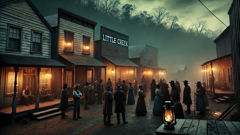
Into the Maw of the Earth
The approach to Bear Hollow Cave was fraught with tension. The woods closed in, thick with the scent of wet leaves and old stone. Branches snagged on sleeves and hats, but the little group pressed forward, nerves wound tight. Isaac led with his lantern, its beam slicing through gloom, Mercy at his side with a notebook—she intended to document every step, every sign, hoping that truth, whatever it was, would shield them from hysteria. As they reached the cave mouth, a wind gusted out, unnaturally warm and rank. The horses refused to come closer. Eli muttered a prayer, his hand brushing the talisman at his neck. They pressed on, ducking into the cool darkness. The air inside Bear Hollow felt heavy. Drops of water echoed from stalactites. Here and there, bones—animal and otherwise—littered the edges of their path, some gnawed clean, others splintered. The group moved slowly, flashlights and lanterns bobbing. Tom found a patch of dried blood on a rock, the drag marks leading deeper. The group’s nerves frayed; Mercy’s hand shook as she scribbled notes. A sudden sound—a low, guttural growl—froze them. For a moment, it seemed to come from everywhere at once. Isaac motioned for silence. They pressed forward, hugging the wall, when suddenly Eli’s lantern flickered and died. In the stuttering light, something massive shifted in the darkness ahead—a shape coiled like a living nightmare, armored hide glittering in their lantern beams, eyes shining gold and red. The Gowrow lifted its head. It was larger than any bear, reptilian yet somehow wrong, horns arching from its brow, a frill of spines running down its neck. It bared teeth like daggers and let loose a roar that shook dust from the ceiling. Panic seized the group. Tom fired his rifle blindly; the bullet sparked off stone. The Gowrow lunged, scattering the group. Isaac grabbed Mercy, dragging her behind a boulder as claws slashed through the space where they’d stood. Eli tripped and fell; the creature’s tail whipped past, narrowly missing him. The group fled, stumbling over rocks and bones, Mercy’s notebook tumbling from her hand. At the cave entrance, they regrouped—breathless, shaken, but alive. Isaac, usually the pillar of composure, was pale. “It’s real,” he whispered. No one argued. They’d seen it: the beast from their childhood stories, more terrifying than any tale.
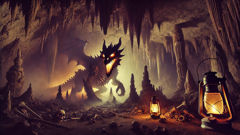
Fire on the Ridge
Word of the encounter raced through Little Creek. Some wanted to abandon their homes; others called for a posse to hunt the monster down. Fear grew with every retelling. Yet Mercy’s resolve only hardened. She argued that panic would be fatal. Instead, she called for calm and careful planning. With Isaac’s help, she mapped every sighting, every track, looking for patterns. They discovered that the Gowrow emerged only on moonless nights, hunting near water. It avoided gunfire but seemed drawn to firelight—perhaps warmth or curiosity. Together, Mercy and Isaac devised a plan. If they could lure it out with a bonfire by the river, maybe they could drive it away for good—or, at least, learn its weakness. Not everyone agreed. Some felt it was madness to tempt fate. But as more livestock vanished and fear threatened to tear the town apart, most consented. That night, under a sky thick with stars but no moon, they built the largest fire Little Creek had ever seen on the riverbank. The entire town gathered—some armed, others clutching talismans or family Bibles. Eli stood watch at the edge, Tom kept his rifle ready, and Mercy stood by the fire with Isaac, both determined not to run. Hours passed. The woods grew silent. Then—a shudder through the earth, a ripple in the water. Out from the trees slid the Gowrow. It was even more terrible in firelight: scales gleamed, smoke curling from its nostrils, massive claws gouging the earth. The crowd recoiled but held their ground. The beast paused, sniffing the air. It advanced slowly, eyes fixed on Mercy. She stood still, heart pounding but face calm, remembering old tales that said the Gowrow respected bravery. She met its gaze. Isaac shouted and fired into the air, startling it. The Gowrow bellowed—a roar that shook the trees—then wheeled and charged at the bonfire. Flames scattered; embers soared skyward. Chaos erupted. Some townsfolk ran, others fired rifles. But Mercy stood firm. The Gowrow halted before her. For a moment, it looked almost uncertain—then turned away, vanishing into the trees with astonishing speed. When dawn broke, the town was still standing. No one had been hurt. The Gowrow was gone. Its tracks led north, away from Little Creek.
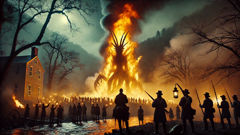
Conclusion
The legend of the Gowrow didn’t end that night by the river. For months, no sign of the creature was found—no vanishing livestock, no shattered fences or bloodied tracks. Slowly, Little Creek returned to its rhythms, but something had shifted in the bones of the place. Children played further from home, daring each other to explore the woods by daylight. Neighbors who’d huddled in fear now greeted each dawn with a quiet pride. Mercy’s notebook, retrieved from the cave by Eli and Tom in a bold act of friendship, became a cherished artifact. She filled its remaining pages with accounts from those brave enough to share their stories. Isaac, once the loudest skeptic, spent evenings on Mercy’s porch, discussing what they’d seen and learned—not only about monsters, but about themselves. In time, the story of the Gowrow became part of Little Creek’s identity. It was retold by lantern light and schoolhouse pageant, growing grander and more mysterious with each generation. Some swore the beast had moved on; others believed it still watched from some hidden hollow, waiting for fear or folly to draw it forth again. Yet most agreed on one thing: whether real or legend, the Gowrow had forged something powerful in their community—a sense that even in the darkest times, courage could be found not just in heroes, but in the hearts of ordinary people willing to stand together against the unknown.

